What did you say to me? Instrumenting User Insights for your AI Copilot
Time to read:
What did you say to me? Instrumenting User Insights for your AI Copilot
AI copilots are the new app UX.
Whether you’re building a chat bot or automated voice systems, your entire application is now only a prompt away from your users.
But how are your users interacting with these new model-powered experiences? And how can you take the ephemeral context from a chat window and use it to personalize the customer experience going forward?
For developers shipping LLM-powered copilots, there’s a new challenge to understand customers’ interactions with these automated systems.
In this post, we’re going to show you how to deploy an AI Copilot experience with advanced instrumentation that allows you to analyze your Copilot performance and persist user context to drive the customer experience across sales, support, and marketing channels.
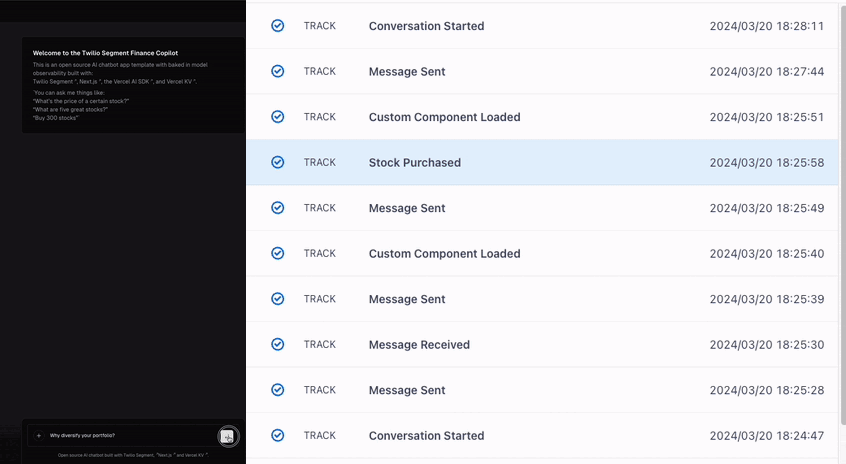

Instrumenting your AI Copilot with Twilio Segment
In this example, we’ll use the Vercel AI SDK and Chatbot template as a starting point. The Vercel AI SDK offers a twist on the traditional Copilot interface: rather than the model responding exclusively with text, the model can respond with text OR interactive components from your application to provide a richer user experience. An introduction to React Server Components (RSC) can be found in the Next.js docs.
We instrument tracking with the Twilio Segment node.js SDK to collect user and copilot behavior. Twilio Segment has integration capabilities for a wide range of other languages, so your analytics instrumentation can span different languages and implementations. We’re utilizing OpenAI’s GPT-3.5 for this showcase, but you can bring your own (customized) LLMs including Anthropic, Hugging Face, and more.
Note: While we’re skipping sign-ups and logins for brevity, it’s best practice to identify your copilot users with first-party data as soon as possible.
Twilio Segment Setup
If you don’t have a Twilio Segment account yet, you can start by creating a new free account here. Once you’ve created your account, create a node.js source in Twilio Segment and note the write key, you will need this later to set up your tracking in the app.


Step 1: Copilot Template Setup
To get started with your copilot setup, follow these steps:
Fork the starter template repository
Create a Vercel account
Set up Vercel postgres
Set up Vercel KV
Populate your .env file with your keys to Twilio Segment, Vercel and OpenAI
The following commands get your app ready and deployed on localhost:
A number of components come pre-configured with Twilio Segment tracking, with the library initiated in the analyticsInstance.ts singleton file. This makes it easy to integrate Twilio Segment on any component or route you want to use it on by simply importing.
Step 2: Define your tracking plan
A clean copilot instrumentation starts by identifying your copilot’s event lifecycle. The Twilio Segment AI Copilot spec gives you an overview of relevant data points to track to understand your users’ interactions with your application. This spec is extensible to your specific use cases, a number of them will be covered in further detail in the implementation guide in this post.


|
Event |
Definition |
Fields |
|---|---|---|
|
Conversation Started |
When a new conversation begins |
|
|
Message Sent |
When a new message is added to a thread by user |
|
|
Media Generated |
When an image or video is generated by the model |
|
|
Feedback Submitted |
When a user rates a conversation or message |
|
You can find the full Copilot spec here.
Step 3: Identify your user
You can track your users in both anonymous and known contexts. While we forgo this in the template, a quick way to do so is to identify unknown users using Twilio Segment’s anonymousId property in an identify call. Generate a unique ID through a method of your choice (e.g. uuid). You can then identify your users with the following Twilio Segment identify call. You can also enrich your user profile with properties if you’d like.
Once your user has given you additional information (e.g. email, user id etc), create another identify call with a userId. This will likely happen on sign-up, and log-in will enable you to track behavior across sessions and devices.
Ensure to pass either anonymousId or userId in all following track/page calls so your copilot interactions get attributed to the correct user.
Step 4: Tracking conversation metadata
Now that your users are identified, you can start instrumenting your copilot interactions. The first key event to track are conversation starts, allowing you to track stats like conversation duration and per conversation message count. The chat.tsx file in the starter template you have forked earlier generates a unique conversation ID for each new conversation, which is attached to all following tracked interactions that belong to the same conversation. The attached Vercel project stores conversation IDs in local storage as newChatId so you can easily grab them across your application.
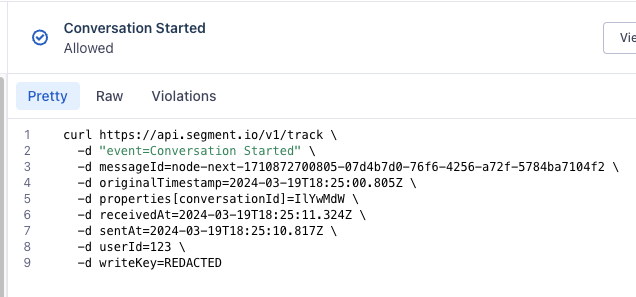

There are a number of extra events and properties you might want to track here, such as Conversation Ended events or specific models used if you have a multi-model setup. The Copilot AI spec has a number of extra events that might be worth exploring.
Step 5: Tracking standard prompts and responses
Tracking user prompts
The next important step is to understand how your customers interact with your copilot. To do so, it’s crucial to know what prompts they are using - Twilio Segment tracks this as a simple track event with Twilio Segment’s library, and passes in the message content as well as message and conversation IDs for full observability. The starter template collects your user’s prompt directly from the client in prompt-form.tsx, but you might wish to collect these from the server side as well using the same mechanism. Please ensure to pass in the relevant userId or anonymousId. The starter template uses hard-coded values for all of them.
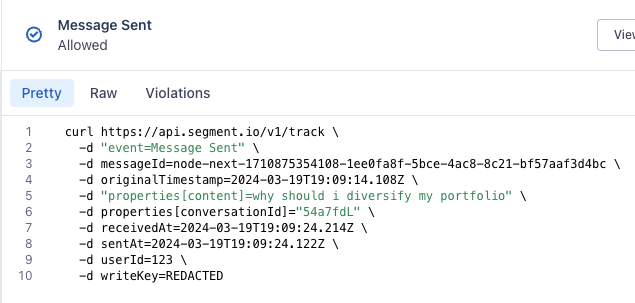

Tracking copilot responses
Of course, you’re not just interested in your users’ prompts, but also the responses they receive from your models. Your app comes with tracking for your copilot’s response in the actions.tsx file of the starter template. The bot response is picked up from the server and sent into Twilio Segment, while simultaneously rendering to your user in their interface. You can of course enter additional properties to this event if you choose.


Step 6: Tracking custom components and interactions
As copilots evolve from being text-only, Twilio Segment helps you track your customers' engagement with custom components that you’ve built or dynamically generated. Robust and data-agnostic tracking allows you to collect data on these interactions just like you would any other data point. The folks over at Vercel have done a great job implementing a number of custom components in the starter pack that are instrumented through Twilio Segment. The template ships with three pre-instrumented custom components, one for displaying multiple stocks, one displaying a stock and its chart price over the day, and one for purchasing stock directly from your copilot.
The first important event to track is how often and which of your non-standard (i.e. text/voice) components are called. This helps you understand which of your customizations are most popular across your user base and helps you focus on iterating them. The starter pack collects (in actions.tsx) the type of component loaded as well as additional information (stock symbols for a daily price chart, an array of symbols for multi-symbol display and purchase levels for purchase components) and sends this data into Twilio Segment.
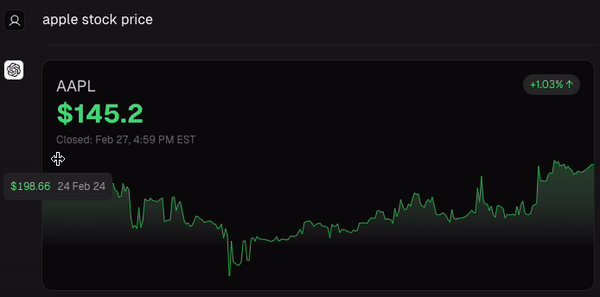

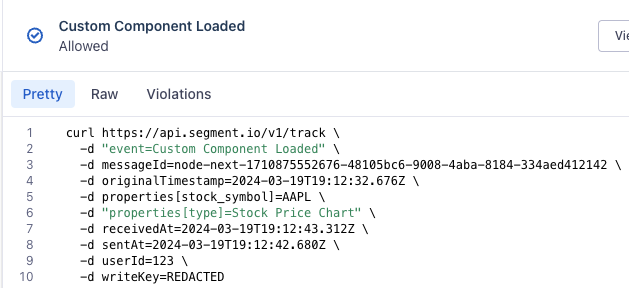

Twilio Segment can not only help you understand the custom components of your copilot, but more importantly, it also enables you to translate them into business relevant events, such as tracking stock purchases directly from custom components. Your app takes the user interaction on the custom purchase component and automatically translates it into a Stock Purchased event in Twilio Segment.
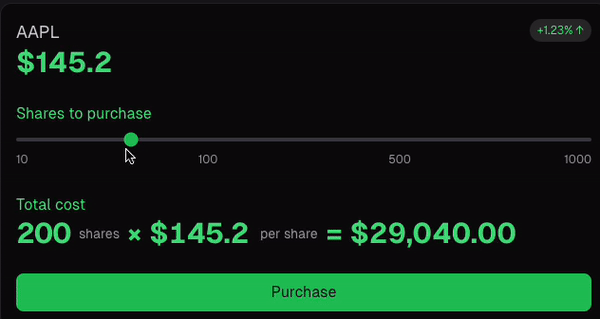

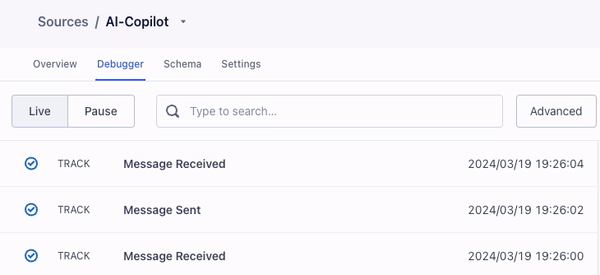



Step 7: 360 Degree Copilot Observability
Twilio Segment’s event and data collection abilities don’t just stop there, but enable full business-centric observability for your copilots. This can also include understanding media your customers generate in your copilots, custom actions that are invoked, and data your copilots get back from your data warehouse. The newly launched AI Copilot spec gives you a baseline of mission critical events you can track with the help of Twilio Segment.
Turning Data into Action
Once collected, Twilio Segment gives you a breadth of tools to help further investigate your copilot’s user interaction by further enriching this data. You can create individual enrichments in computed traits, such as aggregating the number of times individual users have conversations with your copilot, or understanding which components they use most frequently, e.g. which stocks they interact with.




By sending this data to one of Twilio Segment’s downstream partners, you can then activate users based on their interaction or send them to an analytics tool to gain further insight.
One example of this can be pushing your copilot’s user interactions into an analytics tool like Mixpanel to further analyze stats like message frequency per conversation or how many messages your users exchange with your system until they complete a specific action (e.g. a stock purchase).
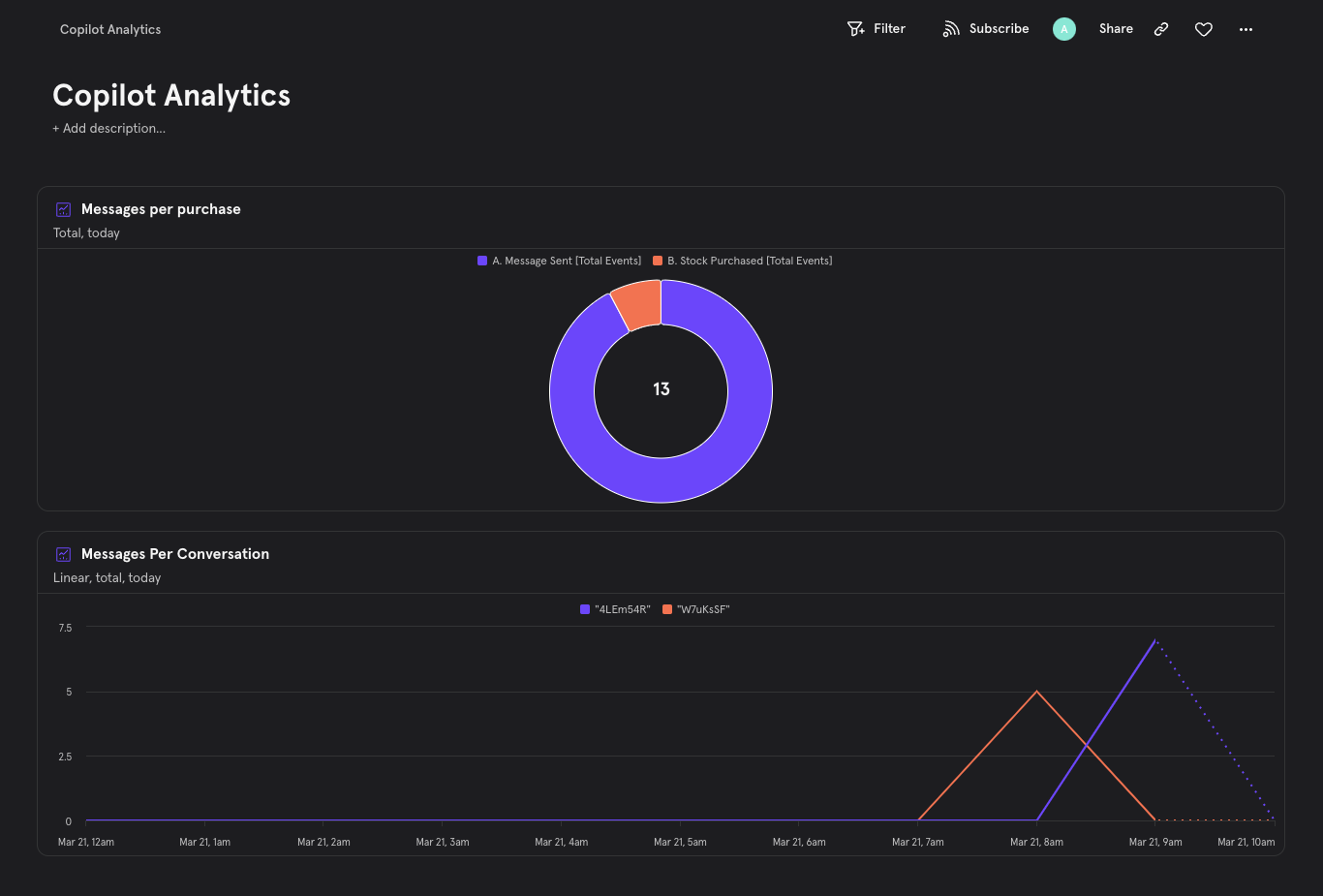

Your AI Copilot in the driver’s seat
By utilizing the outlined instrumentation strategies, not only are you finally understanding the black box of your customers’ conversations with your AI copilots, you are also able to leverage those insights to drive better, more personalized experiences at scale.
Importantly, Twilio Segment’s integration capabilities are not just single-sided. Our Profile API and Functions interfaces also allow you to send consistent, clean, and enriched customer data to your AI Copilot to drive more unique and tailored AI customer journeys.
Ready to see what Twilio Segment can do for you?


The Customer Data Platform Report 2025
Drawing on anonymized insights from thousands of Twilio customers, the Customer Data Platform report explores how companies are using CDPs to unlock the power of their data.
Related Posts
Related Resources
Twilio Docs
From APIs to SDKs to sample apps
API reference documentation, SDKs, helper libraries, quickstarts, and tutorials for your language and platform.
Resource Center
The latest ebooks, industry reports, and webinars
Learn from customer engagement experts to improve your own communication.
Ahoy
Twilio's developer community hub
Best practices, code samples, and inspiration to build communications and digital engagement experiences.


